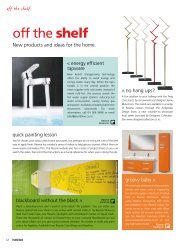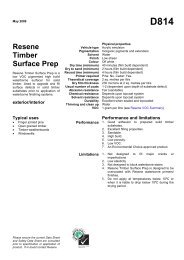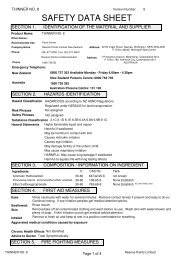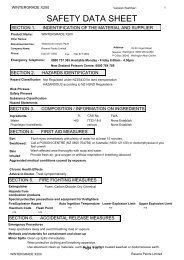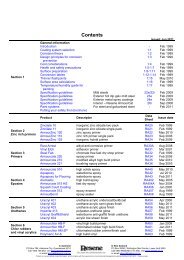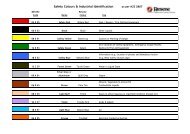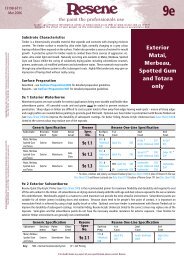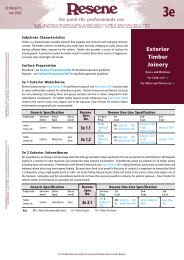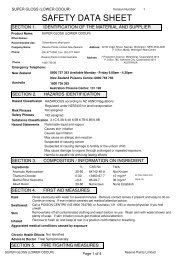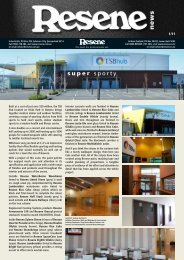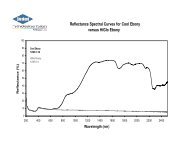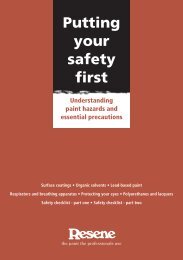Dissolving colour - Resene
Dissolving colour - Resene
Dissolving colour - Resene
- No tags were found...
You also want an ePaper? Increase the reach of your titles
YUMPU automatically turns print PDFs into web optimized ePapers that Google loves.
Notes
<strong>Dissolving</strong> <strong>colour</strong>If you have ever left a note in your pocket when yourclothes have been washed you will know that <strong>colour</strong>scan dissolve making it impossible to read the note. Each<strong>colour</strong> pigment is made up using a mixture of <strong>colour</strong>s.The human eye can’t see the individual <strong>colour</strong>s unless the<strong>colour</strong> is split. You can split <strong>colour</strong> using chromatography,which dissolves <strong>colour</strong>s to see what they contain.Everywhere <strong>colour</strong> - <strong>Dissolving</strong> <strong>colour</strong> 1Notes
Now try it yourself...1Cut a narrow piece of paper towel and draw a line usinga black felt pen about 4 centimetres from the bottom.2Fill a glass half fullwith water.3Place the paper towel in it so the line youhave drawn is about 1 centimetre higherthan the water in the glass. Make sureyour line is above the water. Hold thepaper steady.4The water will be absorbed into the papertowel and through a capillary action will startclimbing up the paper. Once it reaches yourblack line the <strong>colour</strong> will start to dissolve.The dissolving <strong>colour</strong>s will travel upwards atdifferent rates as the water moves upwards.2 Everywhere <strong>colour</strong> - <strong>Dissolving</strong> <strong>colour</strong>Notes
Hold the paper steady andwatch as the water travels uptoward the black line. Whathappens to the black line?Everywhere <strong>colour</strong> - <strong>Dissolving</strong> <strong>colour</strong> 3Notes
Once the <strong>colour</strong> moving upwards has slowed, take the paper towel out of the water and leave to dry. Ifyou look at your paper you can see the original line and see the <strong>colour</strong>s that have dissolved.The inks in felt pens are made up of more than one <strong>colour</strong>. The water spreading separates the <strong>colour</strong>s,which is why you can see many <strong>colour</strong>s rather than just the one <strong>colour</strong> you started with. The <strong>colour</strong>s thatdissolve the best will travel the highest.Try the experiment again this time using other felt tip pens4 Everywhere <strong>colour</strong> - <strong>Dissolving</strong> <strong>colour</strong>Notes
NotesEverywhere <strong>colour</strong> - <strong>Dissolving</strong> <strong>colour</strong> 5
If you were given a note written in felt pen with no name on it, you coulduse chromatography to learn which pen was used to write it. You couldtest the note by placing the bottom in the water and watching the<strong>colour</strong> dissolve. You could then test various pensuntil you found one where the <strong>colour</strong> dissolvesthe same way as the note.6 Everywhere <strong>colour</strong> - <strong>Dissolving</strong> <strong>colour</strong>Notes
Scientists use chromatography to test fordiseases. They compare healthy samplesto samples taken from patients. If thepattern of the patient’s sample is differentto the pattern of the healthy sample thismay suggest the patient has a disease thatneeds curing.Everywhere <strong>colour</strong> - <strong>Dissolving</strong> <strong>colour</strong> 7Notes
Learn more about <strong>colour</strong> with the <strong>Resene</strong> Everywhere<strong>colour</strong> series. Modules include:Changing <strong>colour</strong>Colour wheelsColour and natureColour in artColour of lightDecorating <strong>colour</strong><strong>Dissolving</strong> <strong>colour</strong>Dotted <strong>colour</strong>Everywhere <strong>colour</strong>Eyes and rainbowsFiltering <strong>colour</strong>Illusion and tricks with <strong>colour</strong>Making <strong>colour</strong> - DyeMixing <strong>colour</strong>Reflecting <strong>colour</strong>Safety <strong>colour</strong>Seeing <strong>colour</strong> - AnimalsSeeing <strong>colour</strong> - HumansIn Australia:PO Box 785, Ashmore City, Queensland 4214Call 1800 738 383, visit www.resene.com.auor email us at advice@resene.com.auColours printed as close as printing process allows.In New Zealand:PO Box 38242, Wellington Mail Centre, Lower Hutt 5045Call 0800 RESENE (737 363), visit www.resene.co.nzor email us at advice@resene.co.nzNotes



